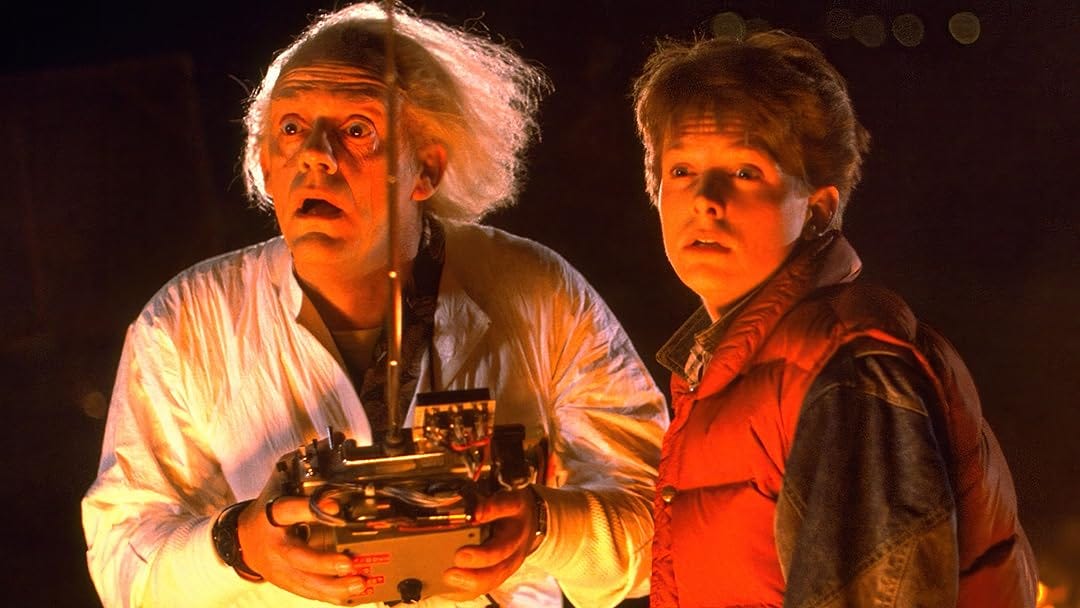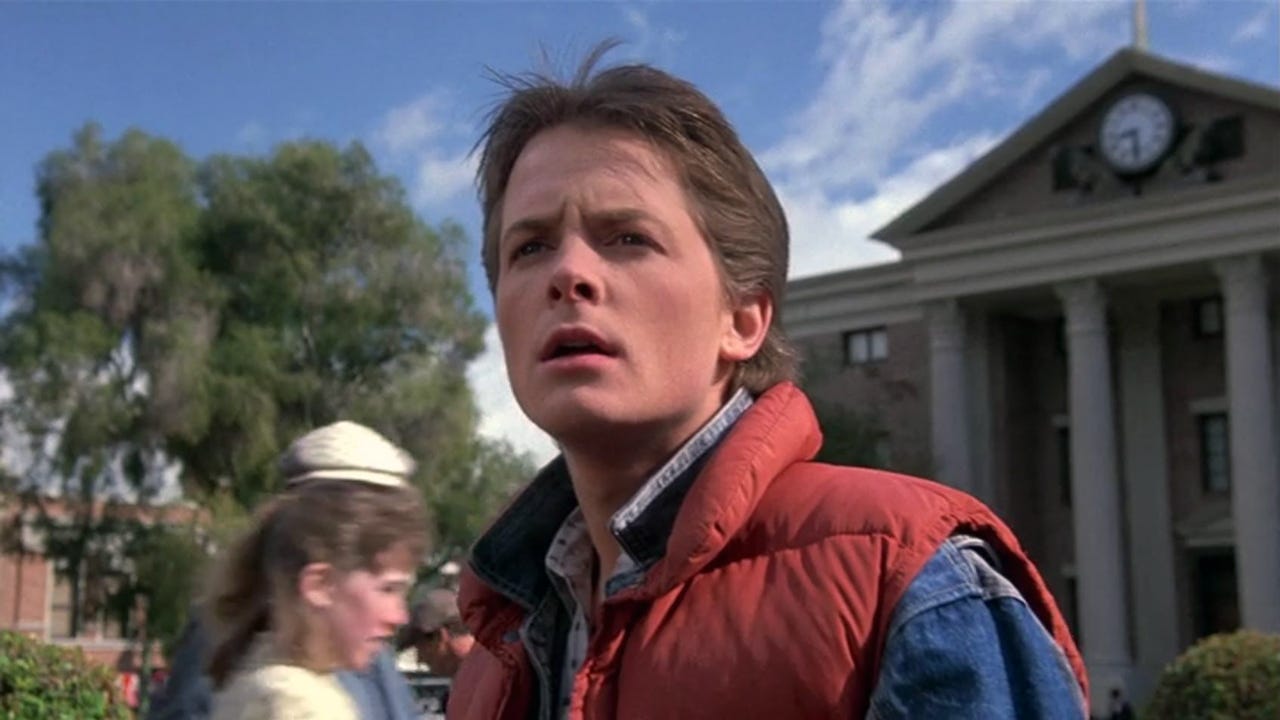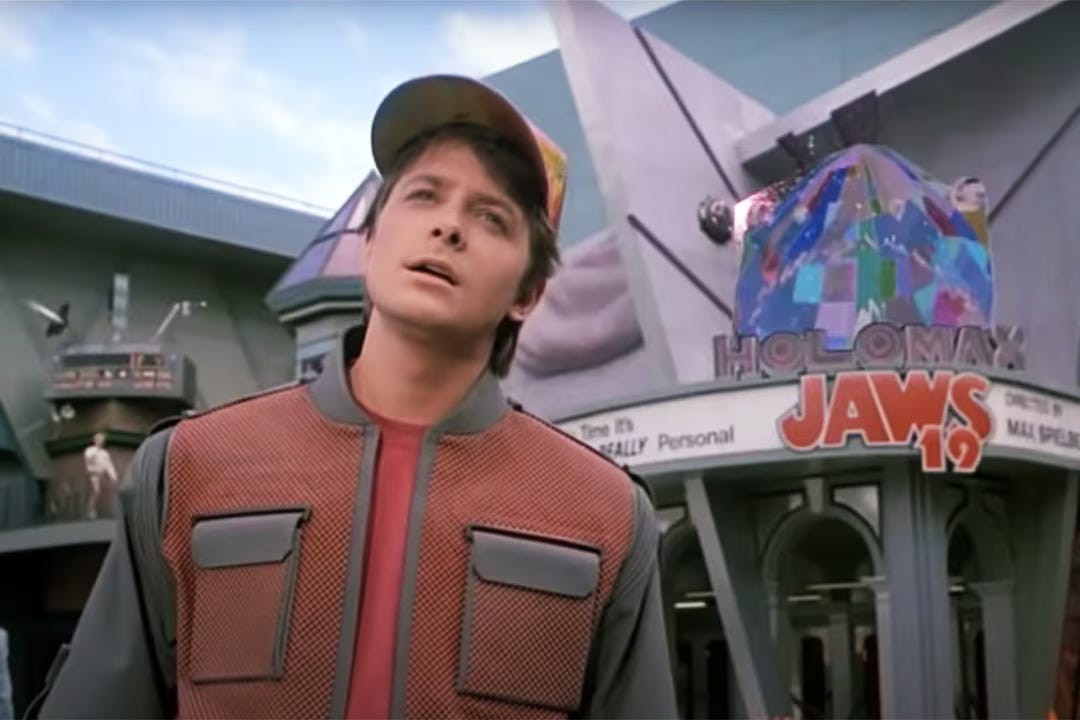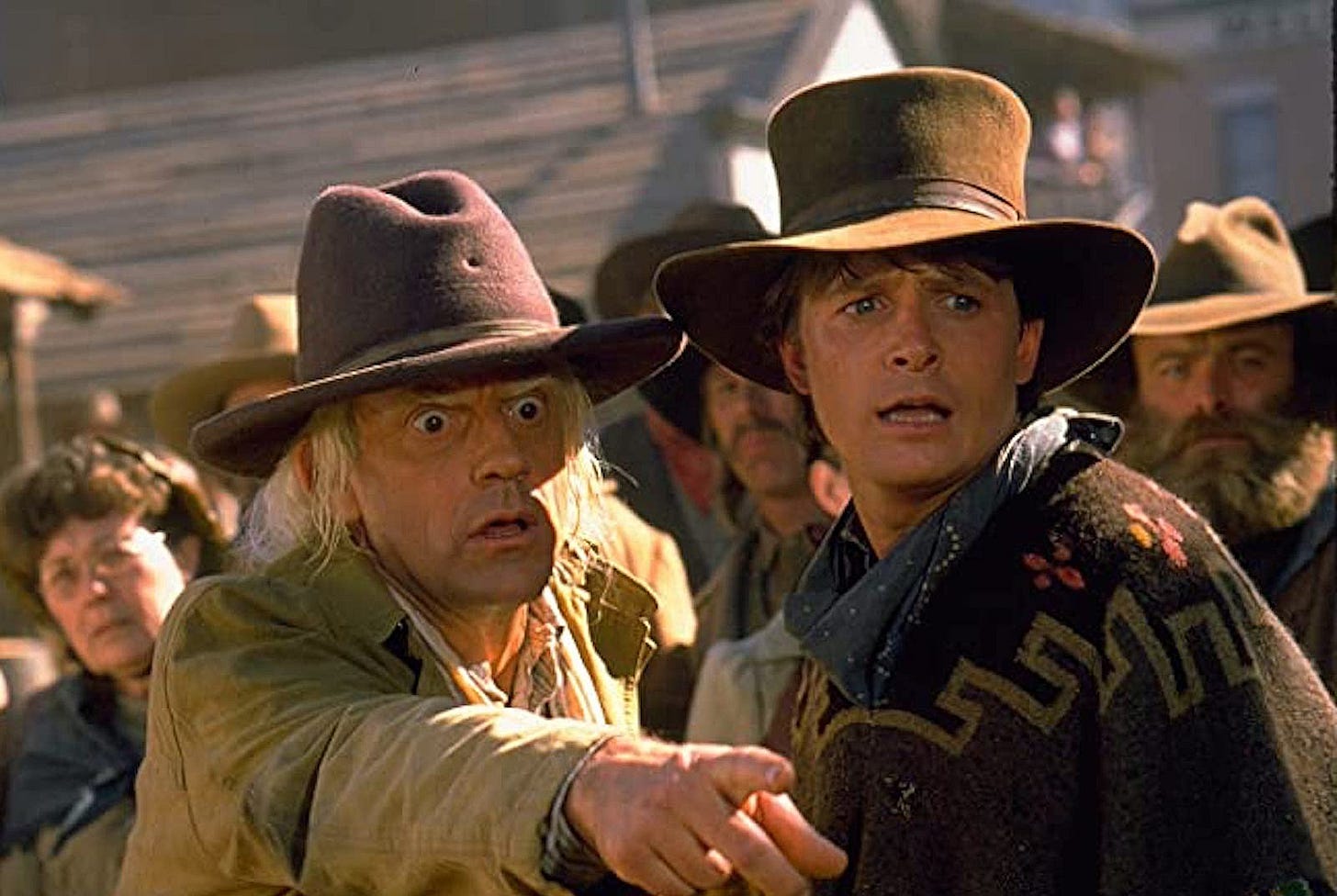I originally planned to devote July’s Franchise Friday to the Back to the Future trilogy in celebration of its 40th anniversary. But in March, my son had tonsil surgery and to get his mind off it, I decided it was a good time to introduce him to Marty and Doc.
I was curious how this might go. Like pretty much anyone my age, Back to the Future is part of my pop culture DNA; it’s the rare movie – up there maybe only with Ghostbusters and Jaws – of which I have never heard anyone say “I don’t like it.” But how does such an 80s-centric movie play to Gen Z, especially considering we’re not only 10 years past its concept of the future, but also that the amount of time between us and the film’s creation is longer than the gap Marty travels in the first film?
We’ll get into some of his specific reactions as we go. But suffice to say when we hit the end of Back to the Future Part III, Mickey turned to me and said, “this is the best series I’ve ever seen.”
You don’t need any other introduction. You know these movies. Let’s speed right up to 88 mph and return to Hill Valley.
A perfect entertainment
There is not much I can say about Back to the Future that hasn’t already been said. It cemented Michael J. Fox as a movie star. It built on the promise Robert Zemeckis showed with I Wanna Hold Your Hand, Used Cars and Romancing the Stone to cement him as an A-list director who would go on to make some of the greatest films of the ‘80s and ‘90s (as well as one I might hate). Zemeckis and Bob Gale’s clockwork screenplay, mixed with the wonder and heart expected of a Steven Spielberg production, resulted in a film I’ve seen countless times that leaves a giant grin on my face every time1.
Do I need to rehash any of this for you? You all know the story of Marty McFly and how he, after learning his scientist pal “Doc” Emmett Brown made a time machine, ends up back in 1955, where he has to make sure his parents fall in love and ride a freak stroke of lightning back home. If you’re a filmgoer of a certain age, this movie is embedded in your consciousness, from those first bars of “The Power of Love” all the way through Doc sliding down the cable as lightning strikes the Clock Tower. It’s not just that this was the most popular movie of 1985; it’s one of the most enduring movies ever. The entire existence of the Universal Studios theme park in Orlando owes its debt to Steven Spielberg wanting to see if they could do for Back to the Future what Disney did for Star Wars2; when the company recently announced plans for a theme park in the United Kingdom, the property proved so beloved that many people speculate it will include an entire Hill Valley land – with a coaster reaching 88 mph, naturally.
Kind of an unexpected fate for a movie about incest.
John Mulaney has a great bit about the film’s decidedly family unfriendly subtext (it’s NSFW, but it’s funny), and part of the film’s behind-the-scenes lore is that it was too PG for studios but passed over by Disney because of its “Mom has a crush on me” subplot. And, yes, the moments where young Lorraine makes passes at Marty hit very weird for my son, who made the comment “If I ever go back in time, I hope Mom doesn’t fall in love with me.” And yet, the content rarely feels like a misstep and the film never feels sordid or icky. The movie’s too charming for that.
Gale famously said that the idea for the film came to him when he saw a senior picture of his father and wondered if they would have been friends if they had been teenagers at the same time. And somehow, despite all the nostalgia riffs and time travel shenanigans, that sweet kernel of inspiration isn’t lost. Back to the Future is often very funny and very thrilling — we don’t talk enough about how well Zemeckis draws out the suspense in those final 30 minutes – but it’s also just a very sweet movie about families and our tendencies to turn into our parents.
I’ve seen this film well over a dozen times, but it’s only been on recent rewatches that I’ve picked up on its undercurrent of sadness. Hill Valley 1985 is a once-charming town gone to the dumps. The Clock Tower is burned out and on the cusp of being razed. Adult bookstores line the main street. Marty’s suburb – the height of future promise and hope in 1955 – is just another sad, dying street thirty years later. His father, George (Crispin Glover), is a nerd still under the thumb of high school bully Biff (Thomas F. Wilson). His mother, Lorraine (Lea Thompson), is an alcoholic who looks at her husband in resignation. Marty’s brother’s a manager at Burger King; his sister seems to exist only to whine. Marty’s band is rejected from playing in the school Battle of the Bands and his assistant principal is always on his case. His only bright spots seem to be his girlfriend as his best friend…a disgraced scientist who lives out of his garage.
The film’s 1955 is bright and poppy, a movie-fied version of that period that probably only exists in memory. But the clean Hill Valley streets and dreamlike chords of “Mr. Sandman” set up a wistfulness that runs through the series, especially the first two films: much of this movie is about the false promises sold to Baby Boomers, and a fear of winding up like our parents. Hill Valley’s Courthouse Square is teeming with optimism and possibility in 1955; there’s an undercurrent of disappointment in realizing those dreams were never fulfilled, for the town or for the people3; at least the movie posits that perhaps Marty can help his mom and dad find a better future, which is why I don’t even mind the celebration of capitalism in the new 1985 Marty makes for himself.
Of course, you don’t dwell on this too much — the movie is too propulsive to linger on Boomer disillusionment. Gale’s script has long been regarded as the standard for delivering an economical, perfectly wound piece of entertainment. There is not a wasted moment or line of dialogue. The opening minutes constantly toss crucial exposition at you, but the movie is so fast and entertaining that it never feels bogged down or talky. Every bit of information comes into play at exactly the time it needs to. There’s an urgency and efficiency to Back to the Future that feels akin to Raiders of the Lost Ark; it’s meticulous without the construction showing.
It helps that Zemeckis and his cast and crew are at the top of their game. The director has always loved his Boomer nostalgia, and the film revels in pop culture commentary (“Ronald Reagan? The Actor!?”). Every performance is iconic. I’m not sure we ever got a young star with the charisma and sheer likability of Michael J. Fox, and this is the role he’s forever had to live down. Likewise, Christopher Lloyd could have created a cartoon version of Doc, but he makes the character quirky as well as a good friend to Marty; knowing Doc ends up penniless gives an unspoken urgency to the moments he learns he’ll successfully create a time machine. And Lea Thompson and Crispin Glover are both wonderful as Marty’s parents, particularly Glover as the geeky George McFly4 – although Thompson’s vivacity gives the film a real charge.
Zemeckis’ filmmaking is fast and light, and the film is a collection of memorable moments, from the chase with the Libyans to the skateboarding sequence, to “Johnny B. Goode” to the mad dash to get back to the future at the finale. Alan Silvestri’s score is one of the great examples about how the right composer can elevate a film to mythic status. Every second is pure joy. It’s so clear in how it lays out its story that its sequel was able to build an entire final act around them. And its characters are so likeable that, 40 years later, new generations fall in love with a movie that should be a time capsule. Back to the Future is great. I’m not telling you anything you don’t already know.
Now, let’s talk about those sequels…
A sequel and sidequel all in one
Back to the Future Part II took a few years to work for me.
I know that all of the 2015 moments – particularly the hoverboard – are its most well-known and beloved. And, of course, when we actually hit that “future” date 10 years ago, they were celebrated once again. But I’ve never really liked the future portions of the sequel; they’ve always felt shrill and cheap.
I think Zemeckis might feel the same way, and after several revisits, I think it’s completely intentional. Zemeckis and Gale never intended on a sequel to Back to the Future and have openly lamented ending the first film on its “To Be Continued…” joke. Their first pass at a second Marty/Doc adventure actually went into the 1960s, finding George and Lorraine in the hippie movement and Marty having to engineer the consummation of their love (I’m kind of glad we didn’t get that). But audiences so cheered at Doc intoning “Where we’re going, we don’t need roads” that it was essential a sequel careen 30 years into the future5.
And you can feel Zemeckis and Gale treating the future sequences as obligatory, a parody of sequels that retread familiar territory. There’s another confrontation in the diner. A hoverboard chase replaces the first film’s skateboards. It works well enough because Zemeckis is in on the joke that this is a rehash, the special effects are fun, and it fits the trilogy’s themes of history repeating itself. But honestly, the look of the future is garish and the acting is grating – not only Wilson as Griff, who’s basically a monster this time out, but also Fox playing multiple roles at Marty’s home in what feels like sitcom shenanigans. It’s goofy and cartoony in a way that misses the heart and charm of the first film, and while I don’t hate it, I’m always a bit happy when Doc and Marty finally head back to what they think is their 1985.
I appreciate the jokiness of that opening stretch a little more now that I see it as the antidote for the darker middle section of the film, when Marty and Doc return to find an alternate Hill Valley under the thumb of Biff, now a balding casino magnate whose comparisons to Donald Trump would have been obvious even in 1989. I’d forgotten how bleak this section of the film gets – Marty’s high school is bombed-out and Principal Strickland is packing a 12-gauge; George McFly has been murdered by Biff; the Courthouse Square looks like a dystopian hellscape.
It’s an interesting and bold pivot for a sequel to a beloved comedy. While I think this midsection works better than the earlier passages – sometimes just due to seeing how weird Zemeckis and Gale are willing to take the script – there’s an acidity that I can’t quite shake. Part of that is the film’s weird racial dynamics; I hate the joke that what clues Marty into the decline of his neighborhood is that his home is now inhabited by a Black family. And it’s unsettling to watch Lorraine, who we loved in the first film, turned into an abused alcoholic while jokes are made about her boob job. I don’t dislike this passage of the movie – I think it sets Biff up as a true threat and Wilson plays him as genuinely sadistic and scary – but I miss the fun of the first film. Of course, that’s part of why the stakes feel so high – everything we loved about the first movie has been erased. We need to get that back – and to do that, we literally have to go back into the first movie.
Whatever flaws the first two-thirds of Back to the Future Part II might have, its final sets completely right. This feels like the movie Zemeckis wanted to make from the start, and the energy ramps up as soon as Marty and Doc head back to 1955. I love how the final act weaves in and out of the first movie, and I can’t imagine the logistical feats that they had to overcome to get this made. Sometimes, it adds a wrinkle to what we already knew – did Biff inadvertently give George McFly a little bit of liquid courage by spiking the punch? – and sometimes Marty being in one place from the first film creates an obstacle for the Marty we’re following. I remember my mom being utterly confused by this movie’s plot when we saw it in theaters – and it’s very possible that this felt brand-new and complex for general audiences upon release. But watching it now, I’m amazed how easy it is to follow despite the narrative pretzels Zemeckis and Gale create for themselves.
Back to the Future Part II is more of an experiment than a story, and I miss the charm and lightness of the first movie even while I applaud how well this story dances with the plot of the first and becomes its own thrilling thing. When I saw this in theaters, I was shocked when it ended on a cliffhanger – and then we got a trailer for the third film right away. And while I don’t think this one works completely, its biggest swings work well enough that it’s a perfectly entertaining follow-up.
Doc in love
The view held by most fans of the franchise is that Back to the Future Part III is the weakest of the trilogy. I understand that argument – it lacks the complexity and imagination of the second film and its structure hews a bit closer to the “save the timeline, get back home” plot of the first film. But I love Back to the Future Part III. What it lacks in originality it makes up for in heart, and watching it again, I’d forgotten how much fun it is.
I love that every film in this series includes the climax of the first, the apex moment of the entire franchise. The second film closes with this moment and the third film opens with it – Doc sending Marty back to the future, only for Marty to return and tell Doc he’s “back from the future.”
What’s different is that this is the first film in the franchise where Doc’s face is the first we see on the screen. And Back to the Future Part III is, emotionally, Doc’s movie. Yes, Marty is still our protagonist, and we still have to deal with the fact that he can screw things up by being provoked6, but Doc’s love story with Clara is the movie’s sweet center.
I love the romance between Christopher Lloyd and Mary Steenburgen. It’s tender and funny, and captures the romantic innocence that the first film found between George and Lorraine. I’m not sure, but I believe this was the only time Lloyd was able to play a romantic lead, and he’s really good at it. It’s fun to watch the cerebral Doc flustered by the unpredictability of love and questions of fate, and there’s genuine heartache when Doc decides he needs to go back home without her. Plus, it sets Lloyd up to do some tremendous physical acting when Doc succumbs to whiskey later on.
I understand that Back to the Future Part III has a more straightforward narrative than its predecessor. Although the time travel story gives it structure, it’s largely Zemeckis’ chance to do an old-fashioned Western. There are fistfights in the saloon, a chase through the dusty streets of old Hill Valley, square dancing, and a train robbery. Having told the sci-fi story they wanted in the first two movies, the trilogy-closer simply has nothing on its mind but to be fun and entertaining, and it works.
In particular, I don’t know that Thomas F. Wilson gets as much credit as he deserves for his work in the franchise. In the first film, Biff is a pretty one-note bully, but there are levels of bitterness, sadism and anger that Wilson brings to the second film that turn him into a truly terrifying foil. It would be easy – and probably forgivable – for Wilson to play Buford “Mad Dog” Tannen as Biff with an accent, but there’s something even fiercer to seeing this bully in the Old West, even as it often gives Wilson the chance for some of his funniest lines (“shoot you down like a duck.”).
And the film’s third-act train robbery is still an impressive and thrilling set piece, a bit of stunt work that constantly tosses complications at its characters as they try to get the locomotive up to 88 mph. The instant Clara shows up to proclaim her love for Doc, the sequence jumps from crisis to crisis, and my son was on pins and needles the whole time, only breathing once Doc and Clara floated off on the hoverboard and Marty disappeared over the gorge.
The trilogy’s conclusion is a point of frustration among some fans. After all, Doc made such a big deal of destroying the time machine – which happens as soon as Marty returns back to 1985 – that it seems hypocritical for him to show up in a steam-powered one at the end. But…I don’t care? There’s a lot that doesn’t make sense in these movies if you think logically, but the secret sauce to Back to the Future is that it pretends to be about matters of the mind but is really driven by the heart. Doc returns because he wants to see Marty again. We want to see Doc again. As the ending to the saga – and I’m glad that, 35 years on, it’s STILL the end of the saga – it’s a final note that makes me happy.
I’ve just spent several thousand words telling you why I love these movies. I have likely told you nothing you don’t already know. But I’m happy to have taken the spin with Doc and Marty again. There’s a reason these films are so beloved — they’re just darn good. And I can’t wait until I need to introduce my daughter to these movies in a few years.
In 2010, for the film’s 25th anniversary, they briefly returned it to theaters. I went with my girlfriend (now wife) to see a Saturday matinee…I had such a blast that I went back two nights to see it again for a repeat engagement.
I experienced this ride in late 1993 when my parents took me to Universal Orlando, this ride set the bar for what a theme park attraction could be; I literally had dreams about it for years following. It’s since been replaced by a Simpsons attraction that uses the same ride system – it’s a lot of fun (with the funniest queue and safety video I’ve seen), but it’s not the same as being pursued by Biff and eaten by a T-Rex.
This is carried over in Part II. Just like Lyon Estates was the promised suburban utopia in 1955 only to be a boring middle-class street in 1985, Marty’s excited to learn he lives in Hilldale in 2015 – which is revealed to have fallen into similar disrepair.
Glover’s dispute over salary caused him to be written out of the sequels, which is why there’s so little of George McFly. It’s the franchise’s one major misstep – especially because, after fighting to undo his dad’s death in Part II, we don’t get a scene of Marty and George face to face…I also think Glover playing Marty’s ancestor in 1885 would be more effective than Fox in the same role.
It also means Jennifer – now played by Elizabeth Shue, after Claudia Wells had to tend to a family emergency – was brought along, even though there wasn’t really a role for her to play. It’s why she spends the majority of Part II and III unconscious and out of the picture.
I don’t know why they decided to insert the “chicken” dilemma in Part II; it feels pat and silly. I don’t mind Marty reacting to people challenging him – even if that’s not part of the first film at all – but the whole “‘chicken’ as trigger word” never works for me. It feels childish.






